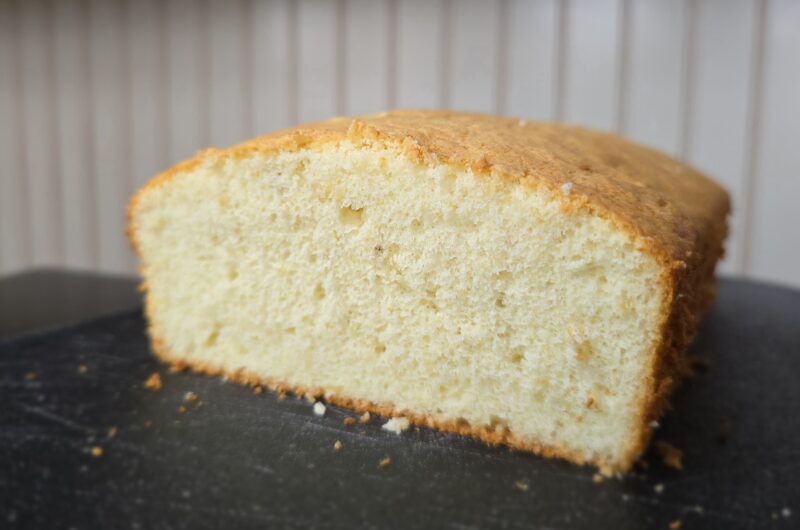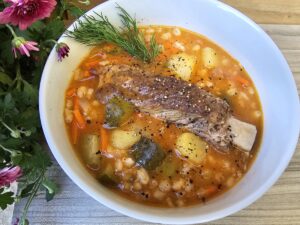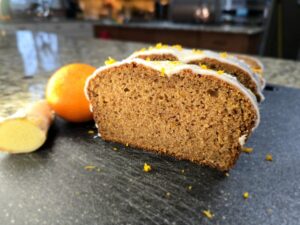This soft, airy Banana Chiffon Castella Loaf is a cross between a Japanese kasutera (カステラ) sponge and a classic banana chiffon cake—light, subtly sweet, and full of banana flavor without being dense or greasy. What makes it special is the unique texture: moist and springy like Japanese sponge cakes, with just enough richness to feel indulgent. On top, a layer of toasted walnuts or pecans, brown sugar, and optional coconut flakes caramelizes into a golden, nutty crust.
This is a loaf you’ll want to slice thick and eat slowly, whether with tea, coffee, or just warm from the oven. It’s also oil-based and uses whipped egg whites (meringue) to rise, making it lighter than banana bread and closer in spirit to kasutera or Japanese-style chiffon cake. It doesn’t rely on heavy butter or a dense crumb—just careful folding and a good rise.
To keep the texture right, be sure not to grease the sides of your loaf pan. The batter needs something to cling to as it rises. Lining just the bottom with parchment ensures a clean release without flattening the sides.
The brown sugar nut topping adds a rustic, sweet crunch and brings depth to the otherwise airy cake. A pinch of cinnamon or cardamom is optional but lovely if you want a subtle spice note.
This Banana Chiffon Castella Loaf is perfect for those looking for something softer and more refined than traditional banana bread, with a nod to Japanese baking techniques and flavor balance.
Banana Chiffon Castella Loaf draws clear inspiration from Japanese baking, particularly two iconic styles:
- Chiffon Cake (シフォンケーキ) – A Japanese favorite known for its airy, oil-based texture achieved by folding whipped egg whites (meringue) into the batter. Your use of oil, meringue, and delicate folding puts it firmly in this category.
- Castella (カステラ or Kasutera) – A traditional Japanese sponge cake originally adapted from Portuguese Pão de Ló. While classic kasutera is made with bread flour, sugar, and eggs (no oil or leavening), your loaf mirrors its moist, fine texture and sweetness balance—especially with the soft banana crumb and slightly caramelized top.
Banana Chiffon Castella Loaf with Toasted Nut & Brown Sugar Top
Ingredients
- Dry Ingredients:
128g cake flour (1 cup plus 2 TBSP, spooned & leveled)
¾ tsp baking powder
¼ tsp salt, gently heaping
- Wet:
3 large egg yolks
45g neutral oil (3 tbsp)
135g mashed ripe banana (about 1¼ bananas)
¾ tsp vanilla
1½ tsp lemon juice
3 TBSP sugar
- Meringue:
3 large egg whites
1/4 tsp cream of tartar, scant or 3/4 tsp lemon juice
1/3 cup sugar
- Topping:
2½ tbsp toasted chopped walnuts or pecans
2 tbsp unsweetened coconut flakes, optional
1 tbsp brown sugar
Optional: pinch of cinnamon or cardamom
Directions
- Prep pan: Line only the bottom of a 9x4” loaf pan with parchment. Do not grease the sides (important for proper rise). Preheat the oven to 325°F (163°C).
- Mix dry ingredients: Sift flour, baking powder, and salt into a bowl.
- Make banana mixture: In another bowl, whisk together the egg yolks, oil, mashed banana, vanilla (or lemon), and 30g sugar until smooth.
- Combine wet & dry: Stir the dry mixture into the banana mixture just until smooth and lump-free. My process for this is to sift half, fold with a large rubber spatula, then sift the rest of the dry mixture and finish folding with a spatula. Don’t overmix.
- Make meringue: In a clean bowl, whip the egg whites and cream of tartar until foamy. Gradually add 60g sugar and whip to medium-stiff peaks.
- Fold: Stir ¼ of the meringue into the banana batter to loosen. Then gently fold in the rest in two batches until well combined—light and airy.
- Pour and top: Pour batter into the prepared pan and smooth the top.
Mix the nuts + brown sugar (and optional spice), and sprinkle evenly over the surface. - Bake:
Bake at 325°F (163°C) for 25–34 minutes, or until the top springs back and a skewer inserted comes out clean or with a few moist crumbs. - Cool: Invert the pan onto a rack if possible or cool upright. Let cool fully before slicing for the cleanest cuts.
Notes
- Serving suggestions:
Serve warm with whipped cream, vanilla yogurt, or honeyed ricotta
Excellent with tea or a small pour of oat milk
Leftovers make amazing next-day French toast slices Thin banana slice on top
Dust with powdered sugar after cooling
Light drizzle of condensed milk for café vibes - More serving suggestions: Mascarpone or whipped cream
Lightly sweetened with honey or vanilla, or even a hint of cardamom
Toasted nuts and honey drizzle
Crushed almonds or pecans + drizzle of warm honey or maple syrup
Sweetened condensed milk + coconut drizzle
Just a thin line across the top or plate
Banana brûlée slices on top
Sear banana coins with a touch of sugar until caramelized, place as topping
Cream cheese glaze or frosting (very thin layer)
Softens the banana intensity and gives bakery-level depth - Tips for the Meringue
The goal is a smooth, glossy meringue that forms stiff peaks — not foamy, dry, or grainy. Start on low speed (Speed 2–3) for 30–60 seconds to loosen the egg whites and form small, stable bubbles. Increase to medium speed (Speed 4–5), add cream of tartar here and beat for 1–2 minutes, or until you see soft peaks begin to form. Next, increase to medium-high speed (Speed 6–8) and gradually add the sugar over 2–3 minutes, one spoonful at a time. After all the sugar has been incorporated, continue beating at the same speed for another 2–3 minutes, or until the meringue is glossy and forms stiff peaks that stand straight up without collapsing. The mixture should cling to the bowl, feel smooth (not grainy), and have a slight sheen. Avoid overbeating, which can dry out the foam and make folding difficult.











